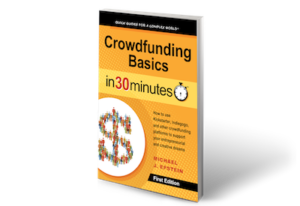Backers typically think of projects as philosophically divided, partially or completely, between two categories: donations and sales. This post explores the two crowdfunding philosophies.
Donation projects are designed to produce art, ideas, social or political movements, services, or public objects that backers believe should exist. Backers typically do not own the final product or outcome, but are satisfied that they could help ensure a worthy creation or specific outcome resulted from the campaign.
For donation campaigns, backers may receive some object commemorating their contribution—a thank you note, an attribution, or a related piece of memorabilia, for example—but the primary outcome is not the object delivered to backers.
There are all kinds of donation-themed projects on sites like GlobalGiving and IndieGogo. I have contributed to charity campaigns including things like training a service dog for a young child with medical issues, bringing solar-powered water pumps to villages in Central America, and helping facilitate a return to school for young dropouts in Kenya. Maybe you have seen your friends sharing links to donation-based crowdfunding projects on Facebook and other social media sites.
 Sales-based crowdfunding
Sales-based crowdfunding
Sales projects seek to raise money to allow the design, manufacturing, and distribution of a physical good that backers desire to possess. Unlike going to a store and buying something that already exists, providing money in advance to a sales-based crowdfunding project enables the actual creation of the product. Advance purchases provide seed capital to cover costs of design and manufacturing that might otherwise be infeasible.
This form of crowdfunding provides a vote of confidence for the creation of innovative goods. I have backed crowdfunding campaigns to directly purchase new and innovative coffee pots, keychains, handbags, and camera gear before they were available for purchase through traditional retailers. Although some of these products later found commercial success through traditional retail channels, others did not.
This is an excerpt from Crowdfunding Basics In 30 Minutes, by Michael J. Epstein. To learn more about crowdfunding or to purchase a copy of the book, visit the About Crowdfunding Basics In 30 Minutes.




